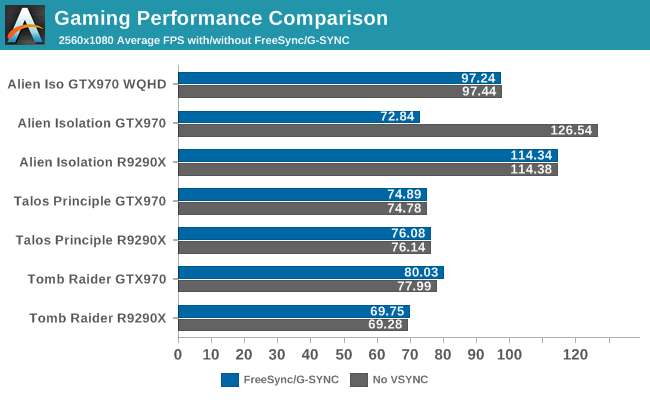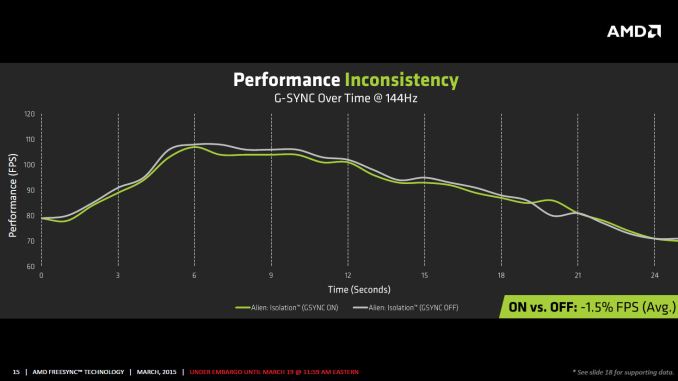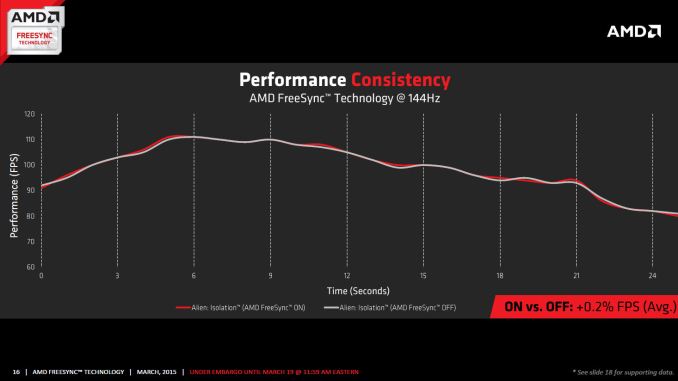The AMD FreeSync Review
by Jarred Walton on March 19, 2015 12:00 PM ESTFreeSync vs. G-SYNC Performance
One item that piqued our interest during AMD’s presentation was a claim that there’s a performance hit with G-SYNC but none with FreeSync. NVIDIA has said as much in the past, though they also noted at the time that they were "working on eliminating the polling entirely" so things may have changed, but even so the difference was generally quite small – less than 3%, or basically not something you would notice without capturing frame rates. AMD did some testing however and presented the following two slides:
It’s probably safe to say that AMD is splitting hairs when they show a 1.5% performance drop in one specific scenario compared to a 0.2% performance gain, but we wanted to see if we could corroborate their findings. Having tested plenty of games, we already know that most games – even those with built-in benchmarks that tend to be very consistent – will have minor differences between benchmark runs. So we picked three games with deterministic benchmarks and ran with and without G-SYNC/FreeSync three times. The games we selected are Alien Isolation, The Talos Principle, and Tomb Raider. Here are the average and minimum frame rates from three runs:


Except for a glitch with testing Alien Isolation using a custom resolution, our results basically don’t show much of a difference between enabling/disabling G-SYNC/FreeSync – and that’s what we want to see. While NVIDIA showed a performance drop with Alien Isolation using G-SYNC, we weren’t able to reproduce that in our testing; in fact, we even showed a measurable 2.5% performance increase with G-SYNC and Tomb Raider. But again let’s be clear: 2.5% is not something you’ll notice in practice. FreeSync meanwhile shows results that are well within the margin of error.
What about that custom resolution problem on G-SYNC? We used the ASUS ROG Swift with the GTX 970, and we thought it might be useful to run the same resolution as the LG 34UM67 (2560x1080). Unfortunately, that didn’t work so well with Alien Isolation – the frame rates plummeted with G-SYNC enabled for some reason. Tomb Raider had a similar issue at first, but when we created additional custom resolutions with multiple refresh rates (60/85/100/120/144 Hz) the problem went away; we couldn't ever get Alien Isolation to run well with G-SYNC using our custome resolution, however. We’ve notified NVIDIA of the glitch, but note that when we tested Alien Isolation at the native WQHD setting the performance was virtually identical so this only seems to affect performance with custom resolutions and it is also game specific.
For those interested in a more detailed graph of the frame rates of the three runs (six total per game and setting, three with and three without G-SYNC/FreeSync), we’ve created a gallery of the frame rates over time. There’s so much overlap that mostly the top line is visible, but that just proves the point: there’s little difference other than the usual minor variations between benchmark runs. And in one of the games, Tomb Raider, even using the same settings shows a fair amount of variation between runs, though the average FPS is pretty consistent.


















350 Comments
View All Comments
steve4king - Tuesday, March 24, 2015 - link
Seiki will be releasing DP1.3 on a 4k monitor Q3 2015, however, for whatever reason, it's still going to be 60hz. Now if other monitors follow suit and R300 also includes displayPort 1.3 we can get out of this bottleneck!wyewye - Friday, March 20, 2015 - link
This is not a review, its a blatant brown-nosing to Amd fest.Nvidia can at any time add support for Adaptive sync in their drivers, thus supporting both Gsync and Adaptive sync.
Amd will never be able to suppory both.
Looks like Nvidia has all the options.
silverblue - Friday, March 20, 2015 - link
They can, but why would they? As for AMD using NVIDIA tech, well... that's a well-trodden path and we all know what's at the end.ijozic - Friday, March 20, 2015 - link
Hmm.. All the listed screens are budget ones.. There are all either TN film or low res IPS screens. I hope it's just time needed for manufacturers to churn out their top models (e.g. 1440p 34" IPS or 27" 1440p 144Hz AHVA) and not some trend.JarredWalton - Friday, March 20, 2015 - link
By your logic all the G-SYNC displays are equally lousy (TN), with the exception of the upcoming Acer XB270HU. It's one of the primary complaints I have with G-SYNC to date: TN is usable, but IPS/AHVA/MVA are all better IMO.Side note: anyone else notice that IPS panels (esp. on laptops) seem to have issues with image persistence? I swear, I've played with laptops that are only a few months old and if you have a static window like Word open and then switch to a solid blue background or similar you'll see the Word outline remain for several minutes. Maybe it's just less expensive panels, but I don't know....
Strunf - Friday, March 20, 2015 - link
I have an Intel CPU and a nVIDIA GC but bravo AMD that despite being some kind of underdog does revolutionize the market on the right way, Mantle, Freesync, what's next?I'm convinced Intel will support Freesync in the near future, I don't see why not, it's free and easy to implement on the graphics circuit and the monitors can benefit from it at almost no cost (proved by the firmware upgrades)...
ComputerGuy2006 - Friday, March 20, 2015 - link
No talk at all about ULMB (Ultra Low Motion Blur)? I am guessing its just not supported?JarredWalton - Friday, March 20, 2015 - link
It's a display feature, not a FreeSync feature.zodiacfml - Friday, March 20, 2015 - link
Just get 120hz displays and be done with it.knightspawn1138 - Friday, March 20, 2015 - link
I think that since AMD has gotten the FreeSync details built into DisplayPort specifications, then all NVidia would have to do to be compatible with a FreeSync monitor is update their DisplayPort to the same revision. G-Sync will have to come down in price, or offer a significant benefit that isn't matched by FreeSync in order to stay viable.